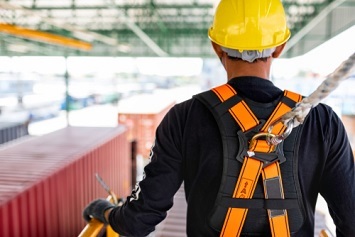OSHA will no longer pursue reconsideration of Arizona’s occupational safety and health program, the agency announced in a July 26 Federal Register (FR) notice (84 FR 35989). OSHA had proposed pulling its approval of the state program over a state fall protection statute that failed to align with federal standards.
States are allowed to operate their own workplace safety and health programs only under plans approved by the federal agency. OSHA conducts all inspections and enforcement of federal occupational safety and health regulations in states and territories without approved state plans.
‘At Least as Effective’
Arizona and OSHA have had conflicts over fall protection requirements since 2011:
- The Arizona Occupational Safety and Health Division (ADOSH) of the Industrial Commission of Arizona on June 16, 2011, adopted a new residential construction fall protection standard (STD 03-11-002);
- Arizona’s new fall protection requirements would be triggered when workers were exposed to heights of 15 feet or greater;
- The trigger for federal fall protection requirements is exposure to heights of 6 feet or greater;
- The change in Arizona requirements would leave workers with little or no protection at heights between 6 and 15 feet; and
- The Arizona legislature then passed state laws codifying ADOSH’s changes.
ADOSH and the state legislature also planned to allow employers in residential construction to use a single fall protection plan for all worksites.
State occupational safety and health laws and regulations must be “at least as effective” as federal standards, to meet the requirements of the federal Occupational Safety and Health Act. Any changes to state safety requirements must be reviewed by OSHA for federal approval.
On August 21, 2014, OSHA proposed rejecting the Arizona residential construction fall protection statute and reconsidering approval of the Arizona state plan.
The federal agency, on February 6, 2015, formally rejected the state residential fall protection law but deferred a final decision on the state plan approval.
The statute codifying the fall protection requirements contained a clause repealing the state law if OSHA rejected the change. OSHA deferred reconsideration with the understanding that Arizona laws and regulations would revert to the federal fall protection standard.
Arizona has since adopted and enforced the federal standard (29 C.F.R. 1926, subpart M). OSHA has monitored the issue closely and concluded the state has successfully implemented the standard.
State Regulations Vary
There are 22 state plans in U.S. states and territories. Some state plans like those in Connecticut, Illinois, Maine, New Jersey, New York, and the U.S. Virgin Islands only apply to local and state government employees. Federal OSHA still oversees workplace safety and health of private sector employees in those jurisdictions.
State laws and regulations must be at least as effective as federal standards. However, some states have standards for which there is no federal equivalent. California has ergonomics and injury and illness prevention plan standards. California and Washington State have standards for outdoor heat exposure. Minnesota has a standard for indoor and outdoor exposures to both cold and heat.
Fall Citations, Fatalities
Failure to provide fall protection remains one of the most frequently cited OSHA violations. In 2017, 887 fatal slips, trips, and falls accounted for 17.2 percent of the 5,147 worker deaths reported in the most recent Census of Fatal Occupational Injuries.
Residential construction workers face fall hazards on ladders, roofs, and scaffolds. Steps that employers must take include:
- Use ladders on flat and level ground and secure and position ladders in the safest possible location;
- Extend the side rails of ladders 3 feet above the roof’s edge;
- Ensure workers maintain three points of contact with the ladder at all times;
- Ensure scaffolds are fully planked, inspect scaffolds and all scaffold parts before each use, and secure scaffolds (locking the wheels on mobile scaffolds);
- Use guardrails or a fall arrest system of scaffolds more than 10 feet above a lower level; and
- Ensure workers use fall arrest systems and that fall arrest systems are correctly anchored.

